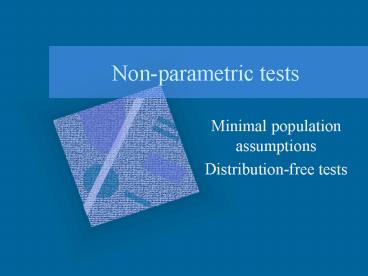Non-parametric tests
1 / 14
Title: Non-parametric tests
1
Non-parametric tests
- Minimal population assumptions
- Distribution-free tests
2
Non-parametric tests...
- The sign test
- The Mann-Whitney U test (Chapter 11)
- Chi-squared
- Wilcoxon matched-pairs signed-ranks test
- Kruskal-Wallis test
- In general, non-parametric tests are less
powerful than parametric tests.
3
Chi-squared (c2)
- c2 requires frequencies in groups.
- Two uses of c2
- Test of goodness of fit
- Test of independence
- c2 compares an observed frequency distribution
with a theoretical model expected frequency
distribution.
4
Models for c2
- The theoretical model may be chance, which leads
us to expect the same number of observations in
each category or group. - Thus, if we have 40 observations and four
categories or groups, we expect 10 observations
in each group. - If we have 107 observations and three categories,
we expect 107/3 35.667 observations in each
category.
5
A non-chance model
- We may have a basis for a non-chance theoretical
model, if prior research or theory tells us the
proportions or percentages of observations to
expect in each group.
6
Examples of theoretical models
- For example, a genetic model might predict
proportions of 9331 for four kinds of pea
hybrids. A sociological model of a neighborhood
might predict 40 single-parent homes, 55
dual-parent homes, and 5 three-parent homes.
7
The goodness of fit c2
- Form your data into columns, one for observed
frequencies fo and one for expected frequencies
fe. - Ensure that the sum of fo the sum of fe.
- Form a third column, fo - fe.
- Form a fourth column, (fo - fe)2
- Form a fifth column, (fo - fe)2 / fe
- c2 is the sum of column 5.
8
An example
- c2 S(fo - fe)2 / fe
- Here is a chi-squared comparing the distribution
of men and women in a class with a theoretical
5050 model - fo fe fo - fe (fo - fe)2
fo - fe)2 / fe - Men 12 15 -3 9 0.6
- Women 18 15 3 9 0.6
- c2 1.2
- df k-11. c2crit 3.84, so retain H0 .
9
c2 test of independence
- The contingency table
- Two grouping variables Are they related or
independent? - Republican Democrat SRows
- Men 10 5 15
- Women 20 30 50
- SColumns 30 35 65
10
Worked example
- Republican Democrat SRows
- Men 10 5 15
- Women 20 30 50
- SColumns 30 35 65
- Obtain fe from the marginal sums. The fe for a
particular cell equals its row marginal times its
column marginal divided by the grand total (30 x
15)/65 for Republican men, for example
11
Example...
- Republican Democrat SRows
- Men 10 5 15
- Women 20 30 50
- SColumns 30 35 65
- Republican men (30 x 15)/65 450/65 6.923
- Republican women (30 x 50)/65 1500/65 23.077
- Democrat men (35 x 15)/65 525/65 8.077
- Democrat women (35 x 50)/65 1750/65 26.923
12
And the c2 is...
- Group fo fe (fo - fe) (fo - fe)2 (fo - fe)2/fe
- RM 10 6.923 3.077 9.468 1.368
- RF 20 23.077 3.077 9.468 0.410
- DM 5 8.077 -3.077 9.468 1.172
- DF 30 26.923 -3.077 9.468 0.352
- c2 3.302
- df (r-1)(c-1)1. c2crit 3.84, so retain H0 .
13
Interpreting c2
- In the goodness of fit test, H0 states that the
observed frequencies are essentially the same
(within chance variation) as the expected
frequencies. - If we reject H0, we believe that the observed
frequency distribution is different from the
model of expected frequencies.
14
Interpreting c2...
- In the test of independence, H0 states that the
frequencies for each group on one grouping
variable are unrelated to (independent of) the
groups of the other variable Political party is
unrelated to gender. - If we reject H0, we believe that the frequncies
for each group on one grouping variable depend on
(are different for) the groups of the other
variable Men and women differ in their political
party.































